The Homeboy Project
- Social Entrepreneurship
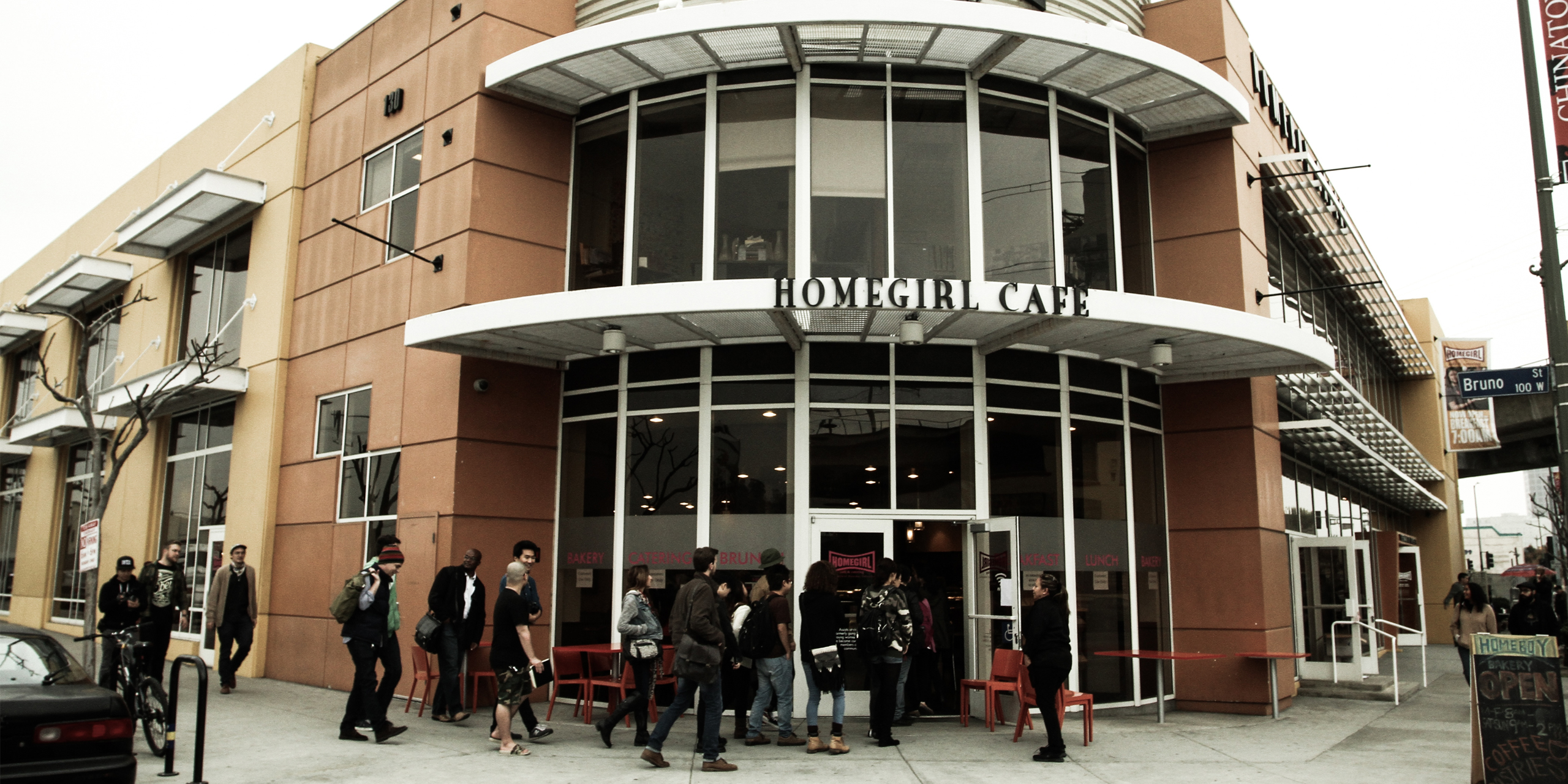
Spring 2014
In the Spring of 2014, Homeboy Industries partnered with Designmatters on a Graphic Design-led studio class with the goal of elevating the Homeboy brand and amplifying its presence in Los Angeles.
For me, I think you captured the stories and it’s always about stories. I feel you captured the true essence of what Homeboy is, and the effect it has had on the people there. [The project] was very uplifting.
– Fabian Debora, Substance Abuse Counselor/Artist, Homeboy Industries
Introduction
Deeply concerned with the increasing gang violence that plagued Los Angeles in the 1980’s (and escalated during the LA riots of the 90’s), Father Greg Boyle set out to make a difference. Only equipped with a bicycle and his powerful heart sense of mission, he took it upon himself to change understand the lives of gang members and their families – offering them a chance to turn their life around. And while he faced insurmountable obstacles in the process, he persisted – and succeeded – in creating the incredible organization ofHomeboy Industries. Most importantly, his unique methodology has transformed the lives of thousands.
Today, Homeboy Industries is the largest gang intervention and re-entry program in the world, celebrating a 25-year influence in Los Angeles as a major catalyst for reduced gang activity, and providing thousands of “second chances” for young men and women through its social enterprises. Homeboy has an astonishing success rate unmatched by any other organization in the country – 70% of participants in the organization turn their back on gang life, compared to a recidivism rate of 70% of other such programs.
In preparation for milestone anniversary and to compliment its fundraising activities, Homeboy partnered with Designmatters and the new INLAB (Insight Lab) at Art Center to elevate the brand and amplify its presence in the city.
This film took the emotionality and very successfully turned it into a call for action. It defined the question of ‘What do we need the public to do?’ and answered it: Make a donation.
– Elisa Ruffino, Director, Designmatters
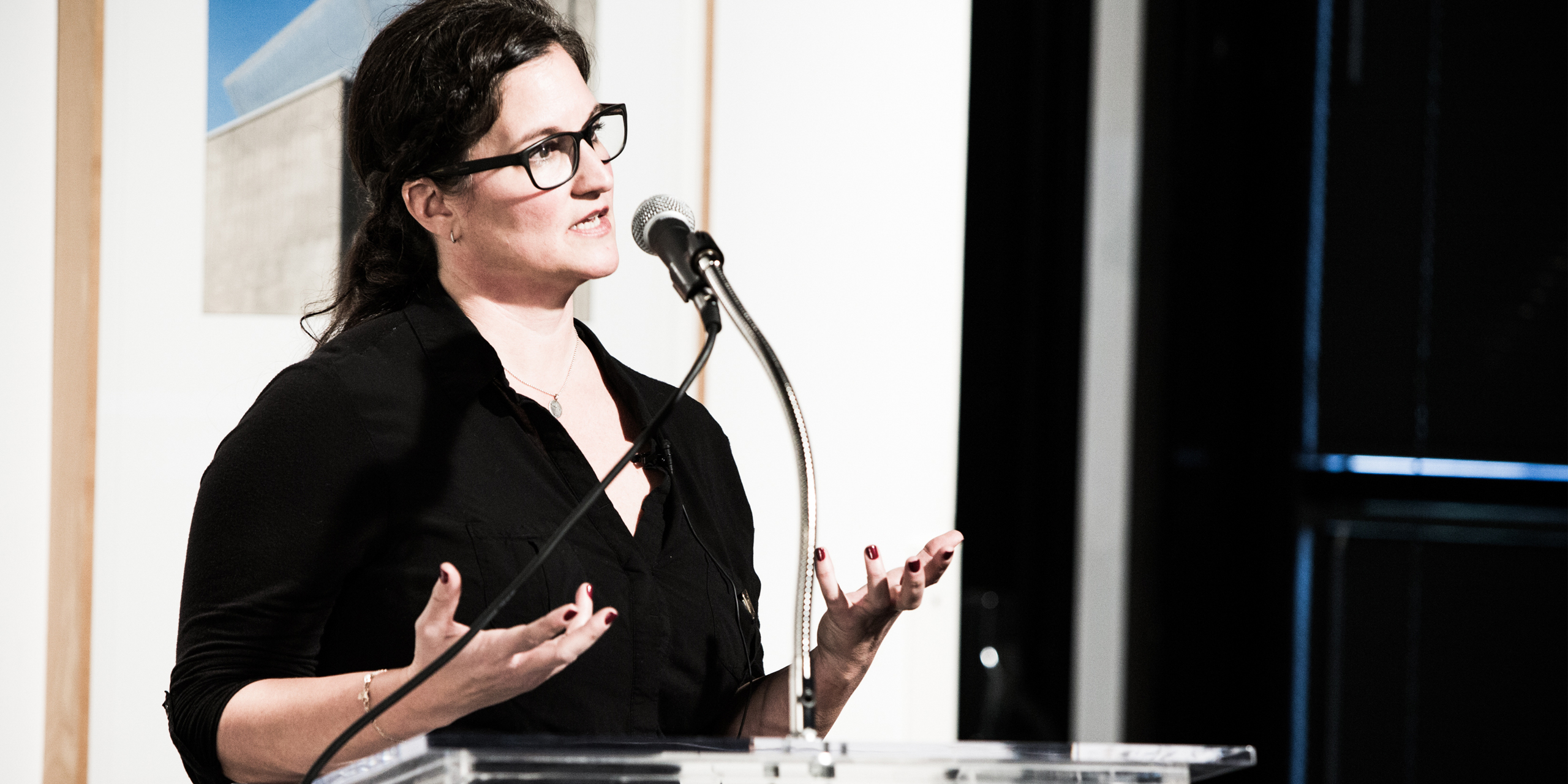
Research and Project Development
Presentations by Homeboy Industries’ leadership team, including Father Boyle, as well as trainees, volunteers and donors provided initial background for both the organization and the “wish list” of deliverables that Homeboy felt could be beneficial to their 25th anniversary celebration. The primary storytelling tool was originally envisioned as an augmented reality exhibition commemorating the 25-year history of the organization and its accomplishments, which could be installed at Homeboy Headquarters.
Following a site visit to the Homeboy headquarters, the project expanded exponentially as students developed a passion for the Homeboy organization and its mission–and the needs of the organization became evident. It was immediately clear to the students that they could develop additional project solutions well beyond the original scope of work. The enthusiasm and dedication of the students and faculty became even more palpable once the development process began. The students began to develop a suite of designs ranging from merchandise to branding to graphic installation options that were then presented to the Homeboy leadership for review and selection. From that, the following were developed for final presentation and consideration.
This project was only a brief moment of involvement for me, but represented a tremendous experience with them.
– Patrick Kim, Student, Art Center College of Design
Project Solutions
A History of Hope
Kevin Staves (GRPH), Julie Yeow (GRPH), Angela Chu (GRPH), Shoghak Kazandjian (GRPH)
The timeline, intended for Homeboy Industries lobby, is a visual compilation of historical events that occurred each year from 1985 to today in the life of Homeboy Industries, cross-referenced with significant cultural events in and around the City of Los Angeles. Shown linearly, people visiting the exhibit can access additional information in 3D using their mobile devices. All of the information can be continually updated. A companion book piece was also developed , which can be a “take home” for visitors or a promotional piece.

I had the honor of working with Homeboy Industries for the Art Center Designmatters partnership. Homeboy Industries is an amazing nonprofit organization that has helped thousands of people directly and tens of thousands indirectly through their wide array of gang intervention services. The students were highly engaged throughout the whole process and the end result was an impressive collection of outstanding work that the client absolutely loved.
– Dave Bullock, Faculty, Art Center College of Design
Telling the Story
Film and Photographs
Stand with Us Documentary
Ben Weiss (FILM), Jean Kim (GRAD FILM), Matt Plaxco (FILM), Griffin Yu (FILM), Captions by Brandon Carrillo (GRPH)
This 6 minute film captures interviews with leaders, donors and community members of Homeboy Industries. It tells and shows how lives are transformed by the organization and—even more so–how working with Homeboy is a transformative experience for donors and volunteers who support the organization. This film is intended for use for donor outreach and premiered at Homeboy’s 2014 Lo Maximo event; will be live on the Homeboy website, used for outreach and cultivation, and will also be shown at headquarters.
Capturing People and Process: Photographs
Patrick Kim (PHOT)
These photos captured the essence of Homeboy Industries through portraiture of Fr. Greg and the leadership team, the members of the HB community at work, and the behind-the-scenes of both the headquarters and various sustainable business enterprises of Homeboy Industries. From baking bread to tattoo removal, the photos tell the everyday stories of the people who are Homeboy. Using a large format camera and film, formal black and white portraits were taken of Fr. Greg, the Homeboy leadership staff, and many of the Homeboy trainees. Shooting this way lends itself to large reproduction up to 60×48” without losing any detail, so it will provide many future uses. Additionally, using the tripod builds slowness, echoing the slow process that is involved in the rebuilding of the trainees lives.
Involving Others
Merchandise and Donor Recognition
Working with Homeboy’s existing identity system, an array of merchandise was developed that could be used either for sale in stores/online or as donor recognition gifts.
Concrete Solutions
Angela Chu (GRPH), Karl Walker (IxD)
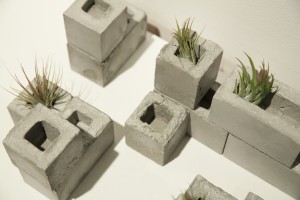 Concrete planters (in several shapes and sizes) represent the streets of LA and hardness of violence. These are filled with soil and plants, representing how the groundwork at Homeboy allows the members of the community to flourish. The pots were designed as donor recognition gifts that could live on a desktop or table to spark conversation and curiosity about Homeboy. They can be assembled in multiples to represent community building.
Concrete planters (in several shapes and sizes) represent the streets of LA and hardness of violence. These are filled with soil and plants, representing how the groundwork at Homeboy allows the members of the community to flourish. The pots were designed as donor recognition gifts that could live on a desktop or table to spark conversation and curiosity about Homeboy. They can be assembled in multiples to represent community building.
Logo bracelets
Kelly Weldon (IxD)
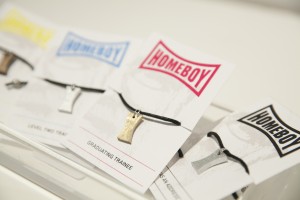 These bracelets were designed using a laser-cut Homeboy logo, finished in natural wood, silver and gold and can be made “in-house” at Homeboy. They would be awarded to trainees’ to mark their progress through the program or could be used for donor gifts at various levels.
These bracelets were designed using a laser-cut Homeboy logo, finished in natural wood, silver and gold and can be made “in-house” at Homeboy. They would be awarded to trainees’ to mark their progress through the program or could be used for donor gifts at various levels.
T-shirts, Tote Bags and Coffee Cup Sleeves
Brittney Au (GRPH)
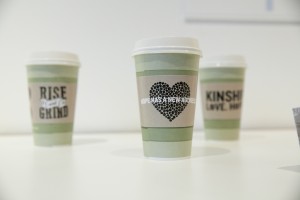 T-shirts designs were developed using a newly-created bicycle “logo,” which represents Fr. Greg’s beginnings in the community, and the “25 Years of Hope” theme. Tote bags included Homeboy Industries and “Made in LA” messaging. Since packaging is a great opportunity to share how purchases help the organizations, coffee cup sleeves were created for the Homegirl Café and other venues to take the Homeboy mission “out into the world”. They are inscribed with inspirational messages and Homeboy/Homegirl logos.
T-shirts designs were developed using a newly-created bicycle “logo,” which represents Fr. Greg’s beginnings in the community, and the “25 Years of Hope” theme. Tote bags included Homeboy Industries and “Made in LA” messaging. Since packaging is a great opportunity to share how purchases help the organizations, coffee cup sleeves were created for the Homegirl Café and other venues to take the Homeboy mission “out into the world”. They are inscribed with inspirational messages and Homeboy/Homegirl logos.
Logo Options for Merchandise and Anniversary Poster
John Lee (GRPH)
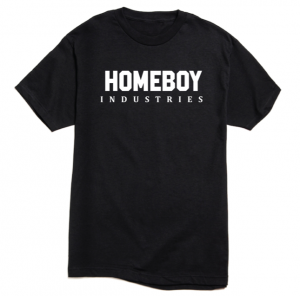 Designs that reinterpreted the existing logo for a flat surface were created for Homeboy/Homegirl for a variety of apparel items for every age – from a golf shirt to youth street wear. Taking into account that Homeboy comes from a street culture, the designs were intended to be hip among youth. Additional t-shirt designs were created to create a specialty line called “The Homeboy Artist Series,” featuring reproductions of artwork by existing Homeboy community members like fine artist Fabian Debora.
Designs that reinterpreted the existing logo for a flat surface were created for Homeboy/Homegirl for a variety of apparel items for every age – from a golf shirt to youth street wear. Taking into account that Homeboy comes from a street culture, the designs were intended to be hip among youth. Additional t-shirt designs were created to create a specialty line called “The Homeboy Artist Series,” featuring reproductions of artwork by existing Homeboy community members like fine artist Fabian Debora.
Father Greg Icon
Julie Yeow (GRPH)
![]()
This iconic black and white illustrated image of Fr. Greg Boyle was designed for use in any number of promotional materials and/or merchandise, and is intended to provide a timeless continuity to Fr. Greg’s iconic presence across all future Homeboy media and merchandising.
Flower Pot/Planter
Brandon Carrillo (GRPH)
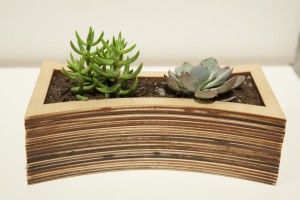 The planter, in the shape of the Homeboy Industries logo, is made of 25 layers of 1/8” plywood that commemorates 25 years of history and the amazing lives that “sprout” out of Homeboy Industries.
The planter, in the shape of the Homeboy Industries logo, is made of 25 layers of 1/8” plywood that commemorates 25 years of history and the amazing lives that “sprout” out of Homeboy Industries.
Interactive Participation
Sharing the Experience
Several interactive designs were developed to make sharing the Homeboy experience mobile and to extend the reach.
25 Years of Transformation: Mapping Events
Brandon Carrillo (GRPH)
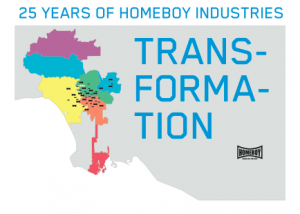 Maps were designed in two formats –interactive, for use on a mobile device with augmented reality graphics, and a poster. Both formats illustrate events and changes that occurred with Homeboy along with those in the Los Angeles area. These maps work in tandem with the History of Hope timeline.
Maps were designed in two formats –interactive, for use on a mobile device with augmented reality graphics, and a poster. Both formats illustrate events and changes that occurred with Homeboy along with those in the Los Angeles area. These maps work in tandem with the History of Hope timeline.
Interactive History for I-Pad / Cup Sleeves
Carissa Atrianty (GRPH)
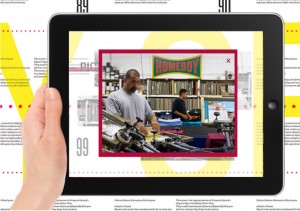 To take the history of Homeboy to a larger audience, an interactive version was created for use on an iPad (or other mobile device). An example was demonstrated using the creation and evolution of the Homeboy silkscreen and embroidery business. Examples of how to share the Homeboy history on cup sleeves were shown, using stories of fictional Homeboy community members over the years.
To take the history of Homeboy to a larger audience, an interactive version was created for use on an iPad (or other mobile device). An example was demonstrated using the creation and evolution of the Homeboy silkscreen and embroidery business. Examples of how to share the Homeboy history on cup sleeves were shown, using stories of fictional Homeboy community members over the years.
HB Impact Map
Patrick McCrory (IxD)
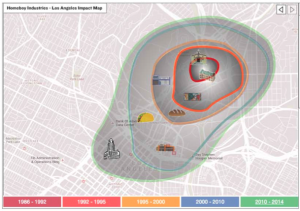 This map combines stories of the founding and growth of Homeboy and how it is ingrained with the Los Angeles culture and places that Homeboy has actually impacted throughout the Los Angeles community. With a timeline across the bottom, users can select a decade and the stories will appear in their respective location on the map.
This map combines stories of the founding and growth of Homeboy and how it is ingrained with the Los Angeles culture and places that Homeboy has actually impacted throughout the Los Angeles community. With a timeline across the bottom, users can select a decade and the stories will appear in their respective location on the map.
Web-based Game about Tattoo Removal
Jeff Guo (IxD)
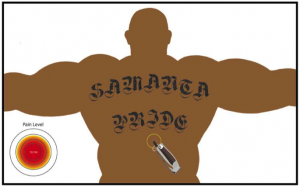 Experience what it is like to have tattoos removed – both the pain level endured and time it takes. Scores are based on the time each player uses to eliminate the tattoos.
Experience what it is like to have tattoos removed – both the pain level endured and time it takes. Scores are based on the time each player uses to eliminate the tattoos.
Photo Essay
-
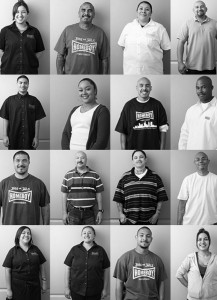
-
Capturing People and Process: Photographs by Patrick Kim
These photos captured the essence of Homeboy Industries through portraiture of Fr. Greg and the leadership team, the members of the HB community at work, and the behind-the-scenes of both the headquarters and various sustainable business enterprises of Homeboy Industries.
Download PDF
